We run a diverse range of projects to engage volunteers, covering a broad spectrum of interests.
Read about our current opportunities.
State Papers Domestic, William and Mary, combined volunteering cataloguing project
In December 2021, a team of three dedicated volunteers commenced the combined project to catalogue both the SP 32 ‘State Papers Domestic, William and Mary and the SP 33 ‘Large Document’ county tax assessments. Although most of these bound letter books cover the period from the Bill of Rights in 1689 to the death of William III in 1702, there are some stand-alone papers which date back to the reign of Charles II (and forwards to George II). While the greater part of this collection is written in English, there are discrete runs of correspondence in both French and Latin.
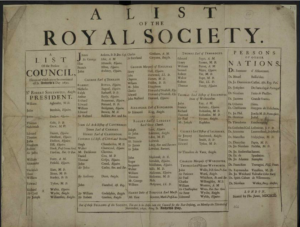
SP 32/3/84/246
A total of 21 pieces were enhanced, with the creation of 2,696 new item level descriptions added to the Discovery Catalogue. Although SP 33 is almost entirely composed of subsidies granted to the crown for the war against Louis XIV, there are also a few miscellaneous documents such as the highly illuminated 1695 letters patent of the Queen Dowager, Catherine of Braganza in SP 33/A. The majority of SP 32 relates to ‘in-letters’ and despatches from the Secretary of State James Vernon (and under-secretary Robert Yard) to Lord Ambassador Joseph Williams at the Hague, and to parliamentary proceedings.
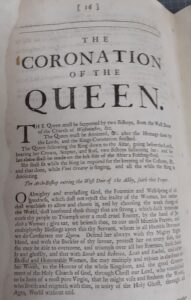
SP 32/1/18/189, f 45
This collection is extremely diverse, and includes material on the Williamite War in Ireland (such as the ’Articles of Surrender’ given to the garrison of Cork under the governorship of Roger MacElliot by the Earl of Marlborough, John Churchill in September 1690 in SP 32/3/27 f.53); the many Jacobite intrigues against the person of the King himself (such as the notorious ‘Fenwick Plot’ of 1696), and the mounting re-coinage crisis of the latter 1690’s.
International trade, diplomacy and major conflicts are also covered, with reports on the ill-fated Scottish colony of Darien on the isthmus of Panama, the long-drawn out death of Carlos II of Spain, and the military expeditions to mainland Europe as part of the ‘Grand Alliance’ against Bourbon France. Records concerning piracy are also to be found, one of several highlights being the reported capture by William Kidd in 1698 of a 400-ton merchantman (the treasure ship Ganj-i-Sawai) belonging to subjects of the Mughal Emperor Aurangzeb in the Indian Ocean in SP 32/11/40 f.51.
Many thanks to my volunteers, who finished the project in very good time, often working remotely at home in quite challenging circumstances, and to members of the CTD department for their help and advice.
WO 416 – German record cards of British and Commonwealth Prisoners of War and Civilian Internees
In February 2017, our dedicated Tuesday onsite cataloguing volunteers embarked on a project to make accessible some newly transferred 417 boxes from the Ministry of Defence containing tens of thousands of personnel cards for British and Allied Prisoners of War and Civilian Internees captured in German occupied territory during the Second World War. As well as cataloguing personal history cards for over 200,000 individuals, the volunteers, some of whom have been supporting us for nearly twenty years, also removed staples attaching cards together and rehoused the cards from large, unsorted boxes, into separate secure archival envelopes, and, in the process, painstakingly numbered each and every envelope recording summary details. All of these records are in the record series WO 416.
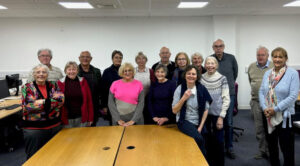
The Tuesday team of cataloguing volunteers, some of whom have been cataloguing with us for nearly 20 years.
Because of the huge effort of the 20 Tuesday volunteers, the National Archives has been able to make available all records for those individuals born more than 100 years ago. Only 7.5% of the collection now remains closed, and each year, until 2028, the vast majority of these records will become open as the dates of birth of all subjects exceed 100 years.
The records are in German and it was never always easy to capture the personal details to enable research from a multitude of users from genealogists to social, medical and military historians.
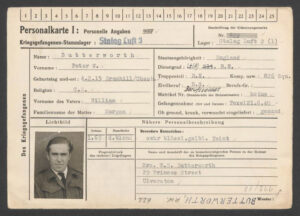
The prisoner of war personnel card for Peter Butterworth, who, after the war, became an actor.
In many cases, some of these details were missing so volunteers would need to check other reliable sources such as the Commonwealth War Graves Commission and other records in the custody of the National Archives such as the 1939 National Register to help verify dates of birth. Information gleaned from other sources are added to item descriptions in square brackets. Also, many cards were misfiled and if these were found in the same box then every effort was made to marry these up as one record though inevitably some records for the same individual were scattered among different boxes. Take the example of James Thomas’ records – filed under both the surname Thomas, James and James, Thomas.
The biggest delay and frustration to the project was COVID which stopped so many things in its track for all of us in 2020 and 2021. As the records contained personal details of living people they couldn’t be scanned to be worked on securely from home. They had to be catalogued onsite using the original records in a secure area. For many months, the volunteers were not able to come onsite as we were all told to stay at home. When restrictions lifted, volunteers could return but social distancing meant that they could no longer work as a group of 20. Instead for much of 2020 and 2021 they could commit monthly, rotating in groups of five each week. Nevertheless, they remained focused and determined to see the project to its conclusion.
Project complete, the data can be fully searched and analysed on our Catalogue, Discovery.
Open items contain full enriched description capturing information described above but the 15,000 closed record descriptions only record full name and year of birth. By the way, closed records can be opened early if an acceptable proof of death is provided. Instructions of how to do this is explained on Discovery
Of the 185,000 opened records, 100,000 relate to British Army personnel, 5,200 with Australian forces, 2,800 with New Zealand forces, and 4,600 with the South African forces. 26,000 were RAF personnel, hundreds of which never actually became prisoners of war – their bodies were found and records were created from the details found by the captors – usually from their dog tags. 2,500 relate to Royal Navy personnel, 3,700 to those serving with the Merchant Navy and there are cards for over 4,000 Civilians, such as teachers, journalists, gardeners, and businessmen. Regardless of their occupation, there are nearly 3,500 individual records for those with the surname Smith and over 1,200 of the 200,000 were born in Hull!
The completion of the project means that we can now consider the digitisation of the collection which ultimately will allow researchers to search and download records in one transaction from anywhere in the world. Given that this is a global collection, this would be of huge benefit to researchers. In the meantime, we will continue to open up some of the stories volunteers have unearthed and match them up with other collections, to get a better understanding of what life was like ‘behind the wire’.
We know these records are incredibly popular – Overall, WO 416 is consistently in our top 5 non digitised collections on a monthly basis (based on the number of catalogue description views per month) with an average monthly page views of 2,900. Plus, with the accessioning and gradual release of British Army Second World War service records, their popularity will only grow.
A huge thank you to our hard working volunteers!
HO 17 – Petitions for mercy
Over the last 12 years, volunteers have catalogued petitions for mercy from prisoners and their supporters submitted to the Home Office between 1821 and 1839. In the 19th century, a prisoner’s only avenue of relief from their sentence was to send a petition to the Home Secretary to exercise the Royal Prerogative of mercy in their favour. The HO 17 series contains nearly 20,000 petitions and related correspondence, and is a treasure trove for both academic and family historians.
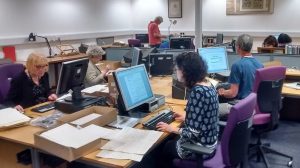
HO 17 volunteer team
The project captured detailed information from the petitions to enhance descriptions in The National Archives’ catalogue and open up the series to researchers by making it more searchable. The series was particularly challenging as the petitions lacked formal structure; they were not referenced in chronological order and each was based on the prisoner’s individual circumstances. Petitions vary from those written formally on parchment with hundreds of signatories, to a barely literate scrawl on a torn piece of paper. The common thread, underlining their importance, is that they reveal details of the prisoner’s life, often in their own words.
Using knowledge and experience gained during the project, the volunteers have given many talks, produced numerous articles, a book and a PhD thesis and will continue to promote the series as an important resource for further understanding the criminal justice system in the early decades of the 19th century.
Using the experience we have gained in editing HO 17, we are now cataloguing the petitions in HO 18, which cover the years 1839-1853.
